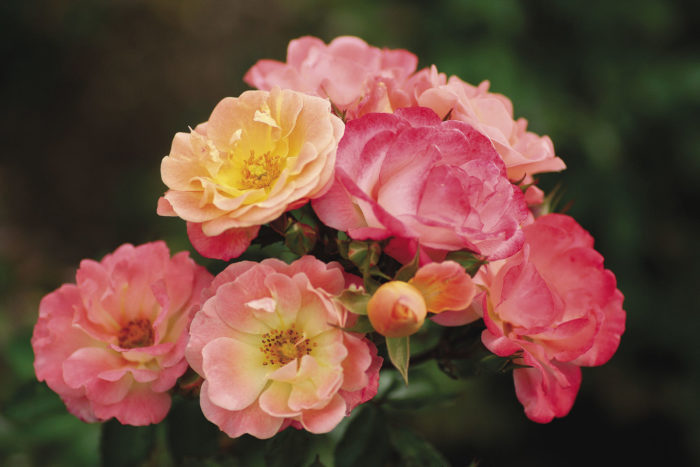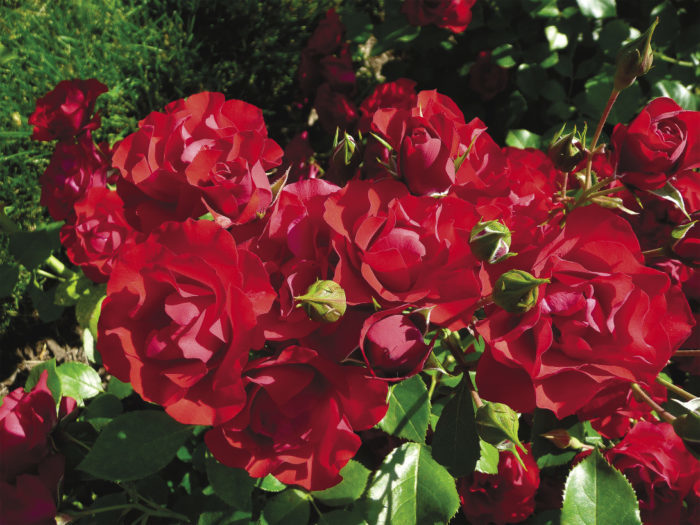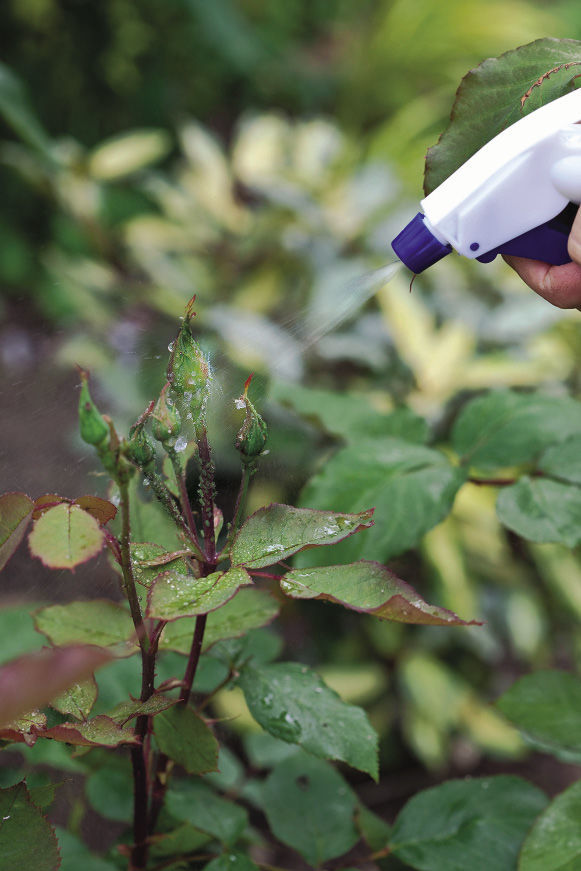Easy, Picture-Perfect Roses
These varieties don’t need lots of primping and pampering to thrive

Have you ever looked through a rose catalog and longed for those gorgeous blooms? You order one, wait impatiently for the day it arrives, and then finally get to give it a home in your garden. You do everything right. But the rose in your garden never seems to look like the one pictured in the catalog. Your rose, in fact, might end up being diseased, dropping its leaves, or having a host of other problems that you just can’t get ahead of.
It might not be your fault. Not all roses are created equal. In more than 20 years of growing roses, writing and lecturing about roses, leading rose trials, and curating a major botanical garden’s rose garden, I’ve learned that there are many great roses but even more bad roses. Maybe the rose you bought, planted, and lovingly cared for wasn’t a great rose to start with. Or maybe it wasn’t a rose that would thrive in your area of the country and you were doomed from the start.
I love the ‘Knock Out’ rose for the simple reason that it got people growing roses again. But there are a lot more roses that guarantee just as much success. With careful selection, you can have beautiful roses without a ton of fuss. Let me introduce you to some roses that I have found completely satisfying on several levels.
‘Poseidon’ is a lavender for warm climates

In my experience of growing roses, I have found that, in hot, humid climates, lavender roses are prone to black spot. But I’ve finally discovered a lavender rose that is resistant to disease: ‘Poseidon’. The growth on this rose is strong, healthy, and full. Its flowers are borne in clusters and have charm and presence. The buds are a darker color—almost the color of plum wine—which contrasts beautifully with lavender. The bloom is fully petaled, and the edges of the petals are almost scalloped, making the blooms look somewhat old-fashioned in a wonderfully modern way. And ‘Poseidon’ has a subtle, pleasant scent.
USDA Hardiness Zones: 6 (5 with mulching) to 9
Size: Up to 4 feet tall and wide
‘Peach Drift’ is nearly always blooming

‘Peach Drift’ is one of the most consistent roses in the garden. It is nearly always blooming, and I have never seen any black spot on my specimens. ‘Peach Drift’ receives, year after year, superior scores from rose trialers. Its blooms are about the size of a quarter. They open up in a soft cupped form to reveal a ruff of stamens. Some people have described a light fragrance with the Drift group of roses, but I have never noticed much.
Zones: 5 to 9
Size: Up to 2 feet tall and 3 feet wide
‘Tequila’ changes colors with shifting temperatures

With ‘Bonica’—a classic powerhouse of a shrub rose—in its parentage, ‘Tequila’ demonstrates the same characteristics of that strong grower with seemingly constant color, reliability, and disease resistance. ‘Tequila’ is a sturdy grower with wonderfully healthy green leaves, which provide a lovely background to the flower display. The fragrance-free flowers are about 2 to 3 inches wide and are generally produced in clusters. I have found that its color can be affected by temperature: Cool temperatures give it more of an apricot color, and hotter temperatures result in a softer yellow. The new flowers are saturated in color, and the older blooms are a bit more faded. ‘Tequila’ grows particularly well in hot, dry climates.
Zones: 5 to 9
Size: Up to 4 feet tall and wide
‘Carefree Beauty’ lives up to its name

‘Carefree Beauty’ is wonderful for northern climates where hardiness is an issue. It was bred in the 1970s by Griffith Buck at Iowa State University, who sought to create a collection of roses that would survive the region’s harsh prairie winters; in this case, hardiness implies toughness. And ‘Carefree Beauty’ lives up to its name with exceptional disease resistance. Its sweetly scented blooms are somewhat soft in appearance, with only about 15 to 20 petals that open up to a soft cuplike shape. I have often given ‘Carefree Beauty’ as a gift, knowing that it will succeed in almost any garden. We all know the success of ‘Knock Out’, so it should come as no surprise that ‘Knock Out’ has ‘Carefree Beauty’ in its parentage.
Zones: 4 to 9
Size: 4 to 5 feet tall and wide
‘Black Forest Rose’ is a promising newcomer

‘Black Forest Rose’ has only been around for a few years but has already established itself as one of the most disease-resistant roses around. I have yet to see any black spot even come near this rose in the gardens or in the trials I am involved with in the Northeast. The healthy, deep green foliage is a beautiful background for the fragrance-free flowers—if, that is, you can see the forest for the trees; this variety produces so many flowers on long sturdy stems that they almost completely cover the foliage. I have seen, for example, up to 50 blooms per cluster on a stem.
Zones: 5 to 9
Size: 3 to 4 feet tall and wide
The blooms of ‘Blush Noisette’ are prolific and fragrant

The Noisette group of roses originated in the early 1800s, and they have proven themselves in the landscape over the centuries. Noisette roses are known as southern plants that thrive under hot conditions, although I’ve had success growing them in some northern states up to Zone 6. The blooms of ‘Blush Noisette’ are not much bigger than the size of a quarter; the blooms, however, are produced in huge clusters, giving a wonderful floral display. With fragrance as a wonderful characteristic of this group, ‘Blush Noisette’ is sure to add charm and beauty to any garden.
Zones: 6 to 9
Size: 6 to 8 feet tall and wide
‘Innocencia Vigorosa’ is covered in blooms

I was struck, from the start, by the health and vigor of this rose. ‘Innocencia Vigorosa’, as the name implies, grows vigorously and is consistently healthy, and the plant has super shiny dark green leaves. I have never seen any black spot on this rose since I’ve had it. As beautiful as the foliage is, however, there is such a sea of softly scented blooms on this plant that, sometimes, you can’t see the leaves. The individual blooms are the purest of white and about 2 inches wide. The white of the petals and the golden color of the stamens is a color match made in heaven; it’s like an elegant white dress dotted with gold beads.
Zones: 6 (5 with mulching) to 9
Size: 2 to 3 feet tall and wide
‘Golden Gate’ is a fragrant golden climber

I have to admit that I’m partial to yellow roses, and this climber is a beacon of yellow. ‘Golden Gate’ is a beautiful climber with large full-petaled flowers that shine like the sun. Its citrusy fragrance is an added bonus to delight the senses. This rose’s growth habit is upright and climbing, but I can also see it grown as a free-flowing shrub, with its arching canes swaying in the wind. I have never seen any black spot on this rose in the Northeast. The foliage is lush and green—an exceptional background to the yellow of the blooms.
Zones: 6 to 9
Size: Climbing to about 8 to 10 feet
‘Larissa’ is the ultimate self-cleaning rose

I promised myself that I would never declare a favorite, but I’ll say it: ‘Larissa’ is my favorite among favorites. When I first planted this rose, it was barely a rooted cutting, so small that I thought it would never survive. From the get-go, the plant has not only survived but also thrived. ‘Larissa’ started sending up strong shoots right away and quickly developed a presence. I’ve never seen a speck of black spot on its foliage. Each of the super-charming old-fashioned blooms is about the size of a quarter, maybe a little bigger. The soft pink can fade in hot climates, but it is still beautiful. Combine 20, 30, or even 50 of these little blooms per cluster and you get quite a display, with enough charm to give a smile to anyone who passes by. And to top things off, the petals fall cleanly from the spent blooms, making it a tidy plant. My garden colleague Kenny, who witnessed ‘Larissa’ from the first planting, often says, “When in doubt, plant ‘Larissa’.” I couldn’t agree more. Its one and only drawback is its complete lack of fragrance.
Zones: 6 (5 with mulching) to 9
Size: 3 to 4 feet tall and wide
‘Cinderella Fairy Tale’ is romantic and old-fashioned

‘Cinderella Fairy Tale’ has clusters of wonderfully frilly, full, pretty pale pink old-fashioned flowers that cover the plant like a big ball gown worn to the Prince’s palace. It is a fantastic grower with healthy, deep green foliage. In all my years of growing this rose, I can’t remember ever seeing black spot on it. The fragrance is described as a powdery fresh, fruity rose fragrance.
Zones: 6 (5 with mulching) to 9
Size: Up to 6 feet tall and 5 feet wide
You can grow roses without chemicals
If the genetics of a rose doesn’t provide great disease resistance, then your rose-growing experience might also involve fungicide. But there are a few things you can do to stack the deck in your favor.

Choose a rose that is suited to your climate
Florida and Iowa have vastly different climates, but for some reason, the same roses are sold in both states. The part of the country in which you live will help dictate which varieties of rose you choose. Ask your regional botanical garden which varieties it is having success with. This information should give you a good starting place when choosing a rose for your backyard.
Give it what it wants
The first step in growing a happy rose is giving it exactly what it wants, rather than watching it struggle under less-than-ideal conditions. Give it at least six hours of full sun per day in soil with good drainage. Give it supplemental water the first year to help it get established; after that, water it only during extreme heat or drought, which will encourage it to develop a strong root system that searches for water. Maintain a 3-inch-deep layer of mulch around the plant, which will preserve moisture, block weeds, and slowly break down to feed your soil and your plant.
Feed the soil, not your rose
Just as eating a healthy, balanced diet is better for you than relying on vitamin supplements, growing your roses in healthy, nutrient-rich soil is better than relying on synthetic fertilizers. If you take fertilizer out of the equation and focus on doing whatever you can to continuously benefit your soil, then your roses should thrive. Add compost to the entire planting bed before planting, and top-dress with compost each season. Apply, on a regular basis, organic fertilizers and amendments, such as fish and seaweed emulsions, composted manures, and chopped leaves.
Peter E. Kukielski, an independent rose consultant, is the former curator and present senior advisor to the Peggy Rockefeller Rose Garden at the New York Botanical Garden in the Bronx, New York. He is the author of the forthcoming book Roses without Chemicals.
Photos: Peter E. Kukielski; millettephotomedia.com; Kor!An/courtesy of commons.wikimedia.org; Jerry Pavia; gapphotos.com
Sources
- Chamblee’s Rose Nursery, Tyler, Texas; 800-256-7673; chambleeroses.com
- Northland Rosarium, Spokane, Wash.; 509-448-4968; northlandrosarium.com
- Palatine Fruit and Roses, Niagara-on-the-Lake, Ont.; 905-468-8627; palatineroses.com
- Roses Unlimited, Laurens, S.C.; 864-682-7673; rosesunlimitedownroot.com





Comments
Log in or create an account to post a comment.
Sign up Log in